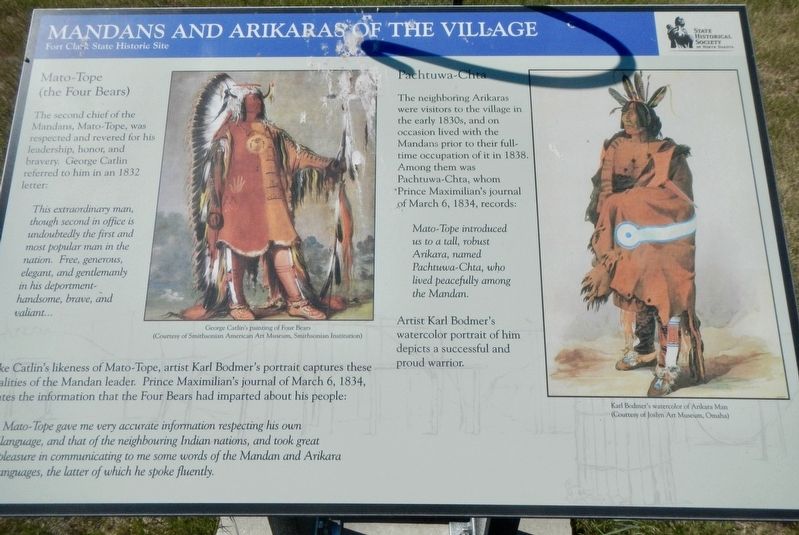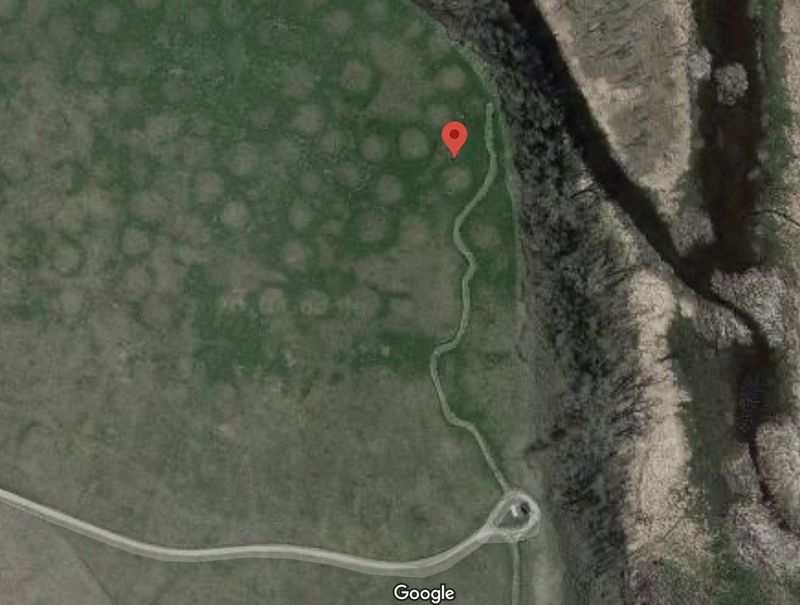Near Stanton in Mercer County, North Dakota — The American Midwest (Upper Plains)
Mandans and Arikaras of the Village
Fort Clark State Historic Site
Inscription.
Mato-Tope (the Four Bears)
The second chief of the Mandans, Mato-Tope, was respected and revered for his leadership, honor, and bravery. George Catlin referred to his in an 1832 letter:
This extraordinary man, though second in office is undoubtedly the first and most popular man in the nation. Free, generous, elegant, and gentlemanly in his deportment in his deportment-handsome, brave, and valiant...
Like Catlin's likeness of Mato-Tope, artist Karl Bodmer's portrait captures these qualities of the Mandan leader. Prince Maximilian's journal of March 6, 1834, relates the information that the Four Bears had imparted about his people:
Mato-Tope gave me very accurate information respecting his own language, and that of the neighbouring Indian nations, and took great pleasure in communicating to me some words of the Mandan and Arikara languages, the latter of which he spoke fluently.
Pachtuwa- Chta
The neighboring Arikaras were visitors to the village in the early 1830s, and on occasion lived with the Mandans prior to their full-time occupation of it in 1838. Among them was Pachtuwa-Chta, whom Prince Maximillian's journal of March 6, 1834, records:
Mato-Tope introduced us to a tall, robust Arikara, named Pachtuwa-Chta, who lived peacefully among the Mandan.
Artist Karl Bodmer's watercolor portrait of him depicts a successful and proud warrior.
Erected by State Historical Society of North Dakota.
Topics. This historical marker is listed in this topic list: Native Americans.
Location. 47° 15.2′ N, 101° 16.377′ W. Marker is near Stanton, North Dakota, in Mercer County. Marker can be reached from 37th Avenue Southwest near 12th Street Southwest (State Highway 200), on the right when traveling north. The marker is located at the Fort Clark State Historic Site. Touch for map. Marker is in this post office area: Stanton ND 58571, United States of America. Touch for directions.
Other nearby markers. At least 8 other markers are within walking distance of this marker. Fort Mandan Overlook (a few steps from this marker); Earthlodges (within shouting distance of this marker); Smallpox and the Central Plaza (within shouting distance of this marker); Stone Shelter (about 500 feet away, measured in a direct line); Winter Villages and Lodges (about 500 feet away); Missouri Valley Environs (about 500 feet away); Corrals (about 600 feet away); Fort Clark (circa 1830-1860) (about 700 feet away). Touch for a list and map of all markers in Stanton.
Credits. This page was last revised on December 14, 2020. It was originally submitted on December 14, 2020, by Barry Swackhamer of Brentwood, California. This page has been viewed 122 times since then and 6 times this year. Photos: 1, 2. submitted on December 14, 2020, by Barry Swackhamer of Brentwood, California.

